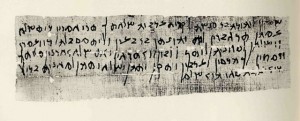 Excerpted from Lawrence H. Schiffman, From Text to Tradition, Ktav Publishing House, Hoboken, NJ, 1991.
Excerpted from Lawrence H. Schiffman, From Text to Tradition, Ktav Publishing House, Hoboken, NJ, 1991.
The debacle of the first revolt against Rome was followed by a period of relative calm. Yet during the years of rule by the autonomous Hillelite patriarchs and the leaders of the tannaitic academies, problems were brewing, both inside and outside the Land of Israel. These developments took place despite the separation of Judea from the province of Syria and the appointment of higher-level Roman governors of senatorial rank. In particular, the need to pay a capitation tax to the Temple of Jupiter in Rome must have made the Jews very unhappy.
It was not until the reign of the Roman emperor Trajan (98–117 C.E.) that the problems came to the surface. In 115–117 C.E., while Trajan was occupied in Mesopotamia, Jews throughout the Diaspora rose up against their non-Jewish neighbors in a violent confrontation. Before long pitched battles were being fought in Egypt. The Jews of Cyrene (in North Africa) were said to have massacred their neighbors. Similar disturbances followed in Cyprus and Mesopotamia. The Roman general Lucius Quietus, ferocious in putting down the Mesopotamian revolt, was rewarded with the governorship of Palestine. When Hadrian became emperor in 117 C.E. he had to spend his first year mopping up the last of the rebels. The Land of Israel seems to have been involved in these battles only to a limited extent.
What is especially significant in these disturbances is the evidence that they were fueled by the very same messianic yearnings that had helped to fan the flames of the Great Revolt and would soon lead to the Bar Kokhba Revolt. To be sure, other social, economic, and political causes were at work, especially a general decline in relations between Jews and their neighbors in the Hellenistic world, but when these finally led to the outbreak of a rebellion, it was the belief in a messianic future that made possible the leap of faith to the belief that the revolt might succeed.
Early in the time of Hadrian there was an abortive attempt to rebuild the Jerusalem Temple, believed by some scholars to have had Hadrian’s support. The failure of this effort was another great disappointment for the Jewish community of Palestine. Soon after, Hadrian founded a city of his own in Jerusalem called Aelia Capitolina, where he erected a temple to Zeus. It is also probable that Hadrian prohibited circumcision even before the Bar Kokhba Revolt, although some see the outlawing of circumcision as a measure enacted after the uprising had begun, much like the persecutions of Antiochus IV. It was in this context, as well as on the basis of the strong messianic yearnings we have observed already, that some elements in the Jewish population of Palestine began preparing for revolt in the 120’s.
The revolt did not begin until it had found its leader. From letters and documents unearthed in the Judean Desert we know the real name of the leader to have been Simeon bar Kosiba. The sobriquet Bar Kokhba, “Son of a Star,” was given to him in accord with Num. 24-17 (“A star shall go forth from Jacob”), taken to refer to the messiah. The tannaim were divided, some supporting his rebellion, others not. Those who supported him saw him as a messianic figure.
The war began as a guerilla struggle against Rome in 132 C.E. Within a short time it had spread throughout the country, and the rebels took Jerusalem, which had not been heavily fortified by the Romans. It is possible that sacrifices were now reinstituted and that work was begun on rebuilding the sanctuary. From the coins Bar Kokhba struck we know of his high priest, Eleazar, who must have taken the lead in efforts to reestablish sacrificial worship. Here we see a reflection of the ancient concept of two messiahs, a lay and a priestly figure, prominent in the Testaments of the Twelve Patriarchs and in certain Qumran scrolls.
We know from the documents that the country was organized into administrative districts, that taxes were collected, and that governmental operations were carried out by Bar Kokhba’s supporters. Bar Kokhba observed Jewish law, and it may be stated that the documents confirm the close relationship between this “messiah” and tannaitic Judaism. Parenthetically, the texts also show that Hebrew was very much a living language at this time, and that, along with Aramaic and Greek, it served a large segment of the population.
Little is known of the actual course of the revolt and of Rome’s successful attempt to regain control. Hadrian sent one of his finest generals, and he succeeded in turning the tide by means of a series of sieges, starving out the rebels in their strongholds and places of refuge. Jerusalem was retaken and future Jewish settlement there was prohibited by Hadrian. The last fortress to fall was Betar, not far to the southwest of Jerusalem, which was captured by the Romans during the summer of 135 C.E. By the end of the war many Jews had been massacred, the land had been devastated again, and distinguished rabbis had been martyred. Indeed, the execution of these rabbis, together with the biblical story of the binding of Isaac, would serve as a paradigm for Jewish martyrdom (termed qiddush ha-shem, “sanctification of God’s name”) in the medieval and modern periods. Once again a Jewish attempt to defeat the Romans and to bring the messianic era had failed.
